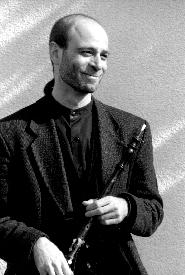|
<< -- 2 -- Jennifer Paull SINGLE VOICE

Benjamin Britten (1913-1976) was primarily concerned with his opera Billy Budd when, in 1951, he wrote the Metamorphoses after Ovid for Joy Boughton (the daughter of the composer Rutland Boughton) to perform at the Aldeburgh Festival of that year.
Metamorphoses, Ovid's fifteen-volume treatise of the disillusionment of his own generation, is depicted through a windowpane of nature's instability. The work abounds with the transformations, mostly of humans and nymphs, into animals, plants, and such imaginative mutations. Surely, a vast palette is the necessary musical translation -- a huge canvass like Debussy's La Mer at the very least could be expected? Boiling it all down to a solo oboe to represent an expression of the original is, to my mind, like reducing Pictures at an Exhibition Mussorgsky/Ravel to a bouillon cube for solo viola. Not the right optic or balance; not the correct proportion for the transition, scale for the canvass, or weight upon the easel. Why one colour for such a huge inspiration? Of course, the composer must write what he wishes, but this work has always left me longing for at least a piano accompaniment if not a string quartet -- but preferably, the whole pyrotechnic show. The original is surely a vast Gobelin tapestry, not a row of petit point cushions?

Matthew Peaceman
|
Matthew Peaceman, whether he is playing modern or baroque oboe shines as a superb craftsman with a baroque soul. His familiarity with the miniaturists of the baroque, les tableaux galants and so much more in his undoubted scholarship, enable him to capture an essence within a cameo portrait frame for each of the six characters portrayed. His musicianship makes him an interpreter who can put more than most oboists into Britten's microscopic mouldings. Many use the work as a means of showing off their technique. Matthew Peaceman interprets the essence of each character to the full, giving as much meaning to the source as is possible within the narrowness of Britten's beams.
Peaceman's opening in the first of the six portraits, 'Pan -- who played upon the reed pipe which is Syrinx, his beloved' is mysteriously distant and full of reverence. Daringly without vibrato, Peaceman weaves a mirage of delicate hues, a spell that sets the tone for a surrealist image stolen from antiquity, with breathtaking diminuendi [listen -- track 1, 0:00-1:34].
Number five, 'Narcissus, who fell in love with his own image and became a flower' is again haunting with this magic. The image reflection can clearly be distinguished from the onlooker gazing upon himself. Matthew Peaceman makes his oboe seem capable of double-stopping; the separate, aquatic or breathing voices of Narcissus are so well defined and independent [listen -- track 5, 0:00-1:25].
I find these two the most lovely of the six movements and the most credible when interpreted by a single oboistic voice, the choice of their twentieth century metamorphosis into music by a perhaps, diverted, or hurried composer?
Continue >>
Copyright © 10 September 2003
Jennifer Paull, Vouvry, Switzerland

|

